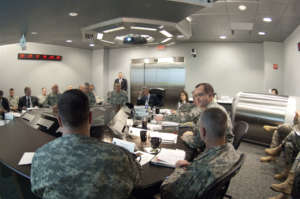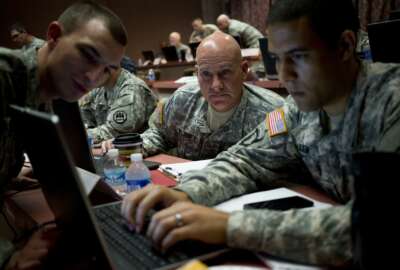

Only 20 percent of the Army's cyber teams are made up of civilians. The Army is analyzing whether that's the right ratio in an environment where every uniformed...
 Since the military services first began building the 133 teams that now make up the Cyber Mission Force, they’ve included a blend of military personnel and civilians. But the balance has been highly lopsided in favor of uniformed service members, a circumstance officials are now reevaluating.
Since the military services first began building the 133 teams that now make up the Cyber Mission Force, they’ve included a blend of military personnel and civilians. But the balance has been highly lopsided in favor of uniformed service members, a circumstance officials are now reevaluating.
In the Army’s case, across its 41 offensive and defensive cyber teams, the mix thus far has been 80 percent military personnel and 20 percent civilians.
“It was built off a model that we thought was most appropriate at the time, but I would tell you we’re relooking at that model,” Brig. Gen. Richard Angle, Army Cyber Command’s deputy commander for operations told reporters Monday. “We now have about two years of operational experience to look back on and say, ‘Is the way we’re organized most conducive to the way we fight in cyberspace?’ I don’t know if it will result in a change — we’re doing the analysis right now — but it’s something we’re looking at.”
The reconsideration comes at a time when the Army’s senior leaders are placing increased emphasis on ensuring that each and every one of the service’s uniformed service members are ready to deploy into combat zones, including by introducing a significantly more difficult physical fitness test that all soldiers must be able to pass in the next two years.
Gen. Mark Milley, the Army chief of staff, said Monday that the new six-event test is designed to simulate 80 percent of the physical demands of land warfare, and the requirements will apply regardless of age or gender.
“We’ve got to get this army hard, and hard fast,” he told reporters. “Combat’s unforgiving. The enemy doesn’t ask whether you’re 25 or 45, they just shoot you, and dead is dead. We want to make sure our soldiers are in top physical condition to withstand the rigors of ground combat.”
Mark Esper, the Army secretary, added that no exceptions will be made for any occupational specialties as the service pushes toward the goal of having 95 percent of its force in deployable physical condition.
“You cannot have a service where some deploy and some don’t,” he said. “Every time a soldier doesn’t deploy, somebody else takes his or her place. So it’s critical that everybody be fit and ready to go.”
While some proportion of the Army’s cyber forces will need to be able to deploy to war zones, it is far from clear that 80 percent of its team members will need to do so.
If the service does opt to rebalance its cyber teams in favor of more civilians, it may lean on new hiring authorities Congress passed in 2015 in order to make the military a more competitive employer of in-demand skills.
The Cyber Excepted Service gave DoD wide latitude to create a separate pay and personnel system, including the ability to make on-the-spot hiring decisions and more flexibility to set compensation than the traditional Title 5 system that governs most civilian employees.
But the Army and other elements of the Defense Department have been slow to make use of the new authority.
Yee said the number of employees the Army had either hired or converted into the Cyber Excepted Service since it was first enacted three years ago is likely in the hundreds, but could not provide a more precise figure. The Army is still developing a plan for how it will use CES and precisely which categories of employees it will apply the new pay and personnel system to.
“But what informs our development of the Cyber Excepted Service is the experiences we had in trying to hire the right people at the pay grades we had available,” said Brig. Gen. Jennifer Buckner, the cyber chief within the Army Staff’s directorate for operations and plans (G-3/5/7). “It was also feedback from employees who decided to leave, or went through an excruciating hiring process. All of those things have informed what we’re doing and where we’re going with the excepted service.”
Copyright © 2024 Federal News Network. All rights reserved. This website is not intended for users located within the European Economic Area.
Jared Serbu is deputy editor of Federal News Network and reports on the Defense Department’s contracting, legislative, workforce and IT issues.
Follow @jserbuWFED


